I’ve recently been reflecting on my list-making tendencies. My propensity to jot things down. My obsession with notebooks. While I do use some digital tools for organising my thoughts, time and time again - literally, daily - I rely on paper outlets to hold the weight of my brain. From appointments to to-do lists, holiday packing lists to my inner most thoughts and feelings, paper diaries, journals and notebooks are my preferred way to unload, track, and tick-off. For me, no app, device or online platform can compete. Anything that is logged in digital form is usually for the benefit of others, in shared calendars or lists; a repeat of what I already have on a trusty paper version.
Physically writing something down, having the connection between my brain, hand, pen and paper, feels crucial to my functioning. Not only do I think it improves my memory and ability to keep on top of things, as well as making me feel more connected to what I am jotting down or thinking through, but it also provides a much-required screen break. I, as I’m sure we all do, surely spend enough time staring at laptop screens, tablets, smart phones - why would we want to spend any more?
Don’t get me wrong, I can kind of appreciate the benefits of digital listing, having apps interconnected and available on different devices to access at your will whenever, wherever you are. But the disconnectedness of different notebooks, how and when I use them, is sometimes part of what helps to compartmentalise my thoughts, so that they’re not one big jumble competing for simultaneous attention.
So this week I’m sharing some of my key paper tools for writing down all the muddles in my brain, and along the way offering some pointers for how you might consider adapting for your own use.
Little Black Book
Affectionately referred to by certain friends as the “little black book”, my daily diary is my bible. I use it for everything.
I’ve had an annual diary for lists and appointments and what not probably since I was 12 or 13, and used to favour large, colourful, chunky finds from the much coveted WH Smith stationary section. But for the last 7 or 8 years, I’ve been a devotee to this particular Moleskin 12 month pocket diary, which features the days of the week on the left, and a blank lined page on the right - perfect for adding specific tasks/appointments to certain days, as well as having an ongoing weekly to-do list alongside.
I write anything concrete in pen, and anything that could change/be cancelled/not urgent to get done that week in pencil, so it can be rubbed out and moved around manually - no need for the click of an edit button.
Yes people laugh at me carrying around my pencil and rubber at all times. Yes it is a running joke when I get out the “little black book” to arrange the next meet up at the end of a meal, while others reach for their phone. But having this physical, visual guide is what helps me organise my thoughts, lists and plans most easily. I can add in tasks to be done in a specific week but without needing to add a specific date, and slot in some scrap paper for something like an ongoing grocery list.
At the end of the year, when Mother Christmas has kindly delivered the new edition, I relish the time spent adding in key dates from the year before, birthdays to remember, and any pre-made plans for that year which I’ll have jotted down in the spare pages at the back of the book.
It gives structure to my days, weeks, months, and there is a safety in being able to carry this around with me at all times.
I realise the paper diary is a dying art and can probably count on one hand the friends who I know for sure still use one. I can accept it’s not for everyone, yet I’ve honestly no idea how people live, function, thrive, without a paper diary.
The Ever-Present, Ever-Changing Journal
Not to be confused with the diary above, this is the ‘thoughts and feelings’ version. Always filled with clear, lined pages; an invitation to illustrate the space with words.
I’ve kept this sort of journal since 2005 (I remember the first book was designed by Jacqueline Wilson and Nick Sharratt - which oddly is still available!). I go through phases of writing regularly and intentionally, then lapse into a phase of letting the journal linger in a drawer for months on end. When I open it back up to write, anything from one page to ten, I’m amazed at how I got through so long without a deep dive into my worries, or jotting down reflections on life events, big or small, that have happened to, or around, me.
I like to choose a notebook that in some way feels inspiring, or comforting; something that makes me want to open it up, pick up a pen, and often sit for an hour or more at a time scribbling away. If you have one that feels a bit bland, jazz it up with a picture or a postcard tacked to the cover. On occasion I’ll receive a notebook as a gift that I instantly know will be perfect for journalling, and the excitement and satisfaction that brings is probably unhealthily intense.
As my journal lives safely tucked away in a drawer, I do have to consciously remind myself to dig it out to write regularly. At times I put it off, thinking I have too much I need to write down and not enough time, or too much has happened that I feel the need to reflect on and I don’t know where to start. But once I do, even if I only have 15 minutes, the words always flow, the thoughts and feelings find a way to come out, and for one reason or another I feel notably better afterwards, my brain more clear than I realised it could or needed to be.


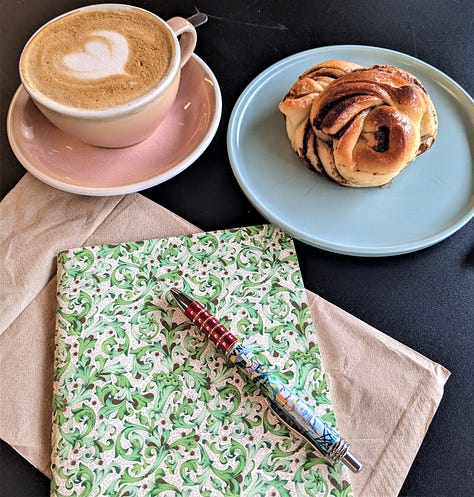
The benefits of journalling, though somewhat co-opted by a wellness movement seeped in capitalism, are often shared and scientifically proven. If you don’t know where to start, prompts are helpful - Jo Club is great for these. If you’re not sure it’s for you, just give it a go. Tell yourself you only need to do it for five or ten minutes and see what happens. I write in full sentences though with a continuous stream of consciousness that can be quite jumbled. You might prefer shorthand or bullet points. One liners on different topics whizzing through your head. Doodles. Or a combination of them all. You’ve got nothing to lose apart from the cost of a cheap notebook. The time spent with a paper and pen won’t be regretted.
Miscellaneous Notebooking
The diary and journal are my star players for writing it all down. They serve all the main purposes; the core outlets for brain-dumping. And yet, of course I have a string of additional journals and notebooks whose contents could, and in some cases should, be rolled into others. But because of my penchant for a pretty cover, and friends and family knowing such a thing is a guaranteed-to-be-loved gift, I find myself in a position of continuing to fill out a whole range of volumes.
There’s the daily gratitude journal, which I’m about half way through, having been on/off filling in for the last six years. When I do input, I usually note down three things I’m grateful for, from people to material niceties to the weather. When I am in a regular practice with this, I notice that I look for things throughout the day to add in when writing before bed, which probably encourages a more positive mindset. Realistically if I just used the main journal for this, it would likely be a helpful way to kick off a longer writing session.
On a similar vein, there is the weekly wellbeing journal, received as a gift last Christmas. I use the blank/lined pages, which are filed between pages to colour and doodle, to jot down a brief list of things that have contributed to my wellbeing in a given week, to try and identify patterns and carry good habits into the following week. I do this on Sunday evenings and have stuck to it pretty religiously since January - bar a few lapses on account of all the bank holiday weekends this year!
Then there is the holiday book, which is part-notebook, part-calendar, part-travel journal. Here I jot down practical details (flight times and numbers, hotel address etc.), notes on what to see/do, what to pack, and then on my return a ‘highlights list’ of key moments I want to remember from the trip. Into these pages I also stuff little mementos, like the beer mat from a cute bar, leaflets for various attractions, and tickets from local transport systems. As with the above, all of this could probably be shared between the diary and journal, making the latter a bit more jazzy.
Alas, I am a notebook tyrant unto myself.
Yet another notebook is saved for memos and ideas related to writing. It contains mind maps for book themes I may (one day!?) explore writing, notes on the publishing industry I’ve picked up from podcasts and articles, ideas for outlets to pitch articles to, and topics/themes I could write about. There’s also some long form writing, mainly from the lockdowns of 2020/21, and a stab at some poetry which is meaningful to me but that no one is ever likely to read on account of it using the same poetry writing ‘skills’ I’ve had since about age seven.
Although this is yet an additional place to make use of a pen, it feels necessary, and helpful, to have a specific place to collect thoughts and ideas around a particular topic, to see how these evolve over time, and refer back to earlier concepts with fresh, more knowledgeable and experienced eyes. While this notebook is for writing about writing – excuse the meta-ness – the notion could be used for any number of hobbies, side hustles or passion projects you might pursue, having one place to keep all your ideas and inspiration. Treat yourself to a notebook that you want to pick up, that you want to spend time adding ideas to, and see how this goes hand in hand with effectively pursing whatever interests your notes relate to.
Planning Ahead
I wrote at the start of this year, in a piece for
, about my first experience of using ’s Project You Journal to help me “design a life I love”. For the uninitiated, life coach Barker created the journal at least six or seven years ago, full of prompts to reflect on the year just gone, and more importantly what we want to come. I found this a helpful way to ignite 2023, including my commitment to write more – though I didn’t know it would come in this Substack form at the time.The reader/writer is encouraged to map out each quarter, remind ourselves of the intentions throughout, and reflect at the end on how this has worked out, before planning out the next three months. So far this year I’ve found it a really helpful way to set intentions and keep myself somewhat accountable, as well as being encouraged to ‘think big’.
While the prompts included could be done in any notebook, the way they are laid out in this targeted journal is a useful approach to the intended activities, and I think there’s benefit in keeping this separate as a way to check in on intentions and plans. There needs to be a level of commitment to complete the first half early on at the start of the year and check in quarterly, but if this level of planning is the kind of thing you’re into, or think would be helpful, I’d recommend this specific journal as a gift to yourself.
I could go on, writing about writing it all down - indeed the first draft of this post was double the length. But thinking about planning ahead seems a good place to end, as I hopefully leave you thinking about how you could delve into the joy of paper notebooks, or learn from my over-enthusiasm to keep your own notebooking more streamline.
How do you navigate writing it all down?
PS…
If you like what you’re reading, and want to help fuel more, you can now buy me a coffee through Ko-fi. While there may be paid subscription features for The Navigation in future, for now all is free to anyone who wants to muse and meander along with me, so this is a way to support my work in the meantime.


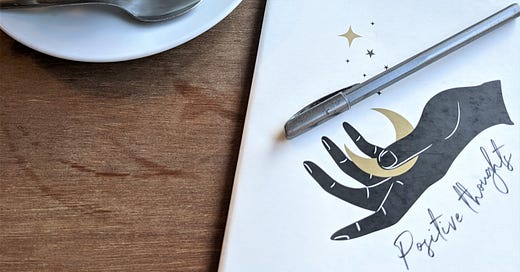


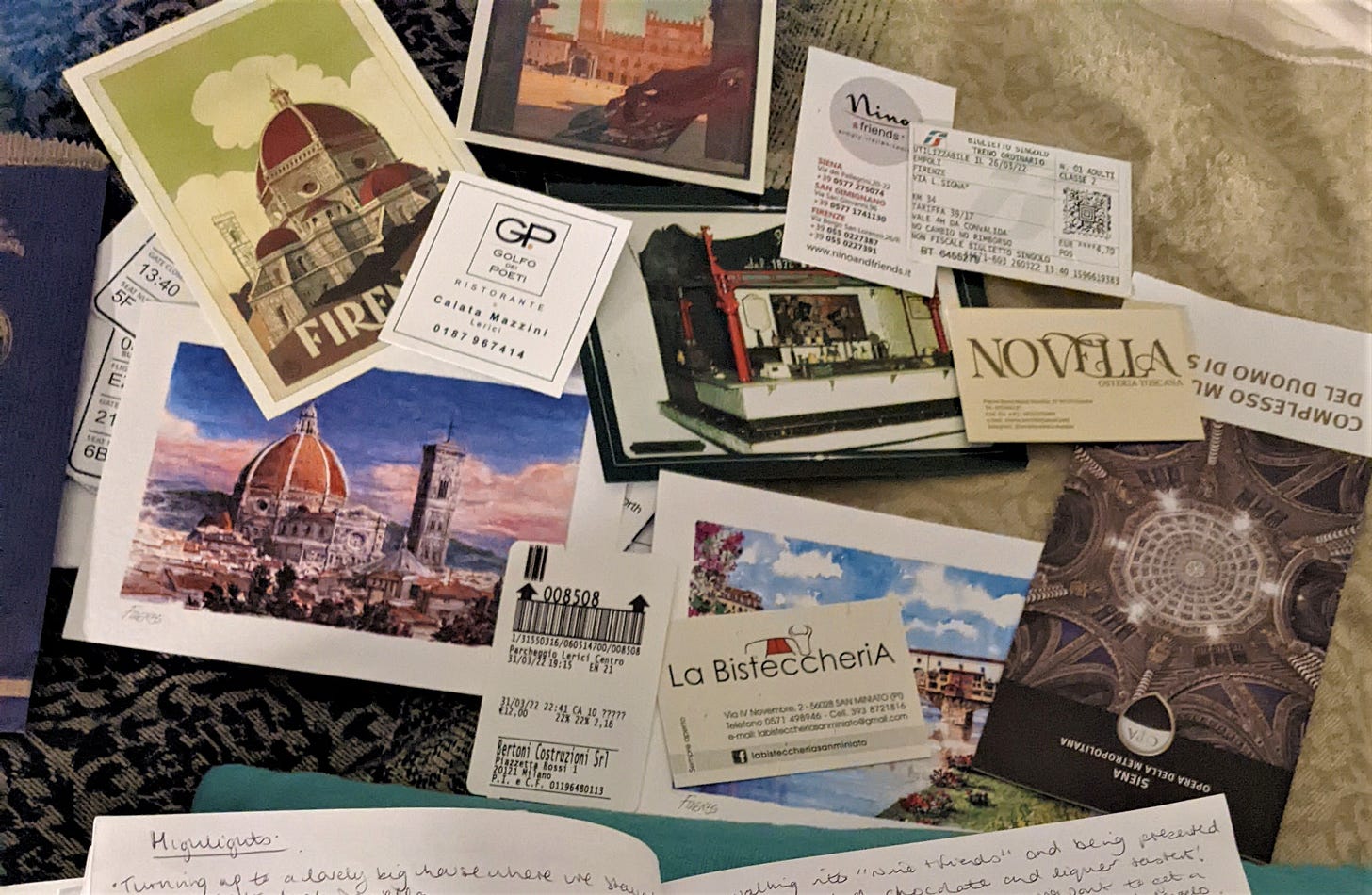
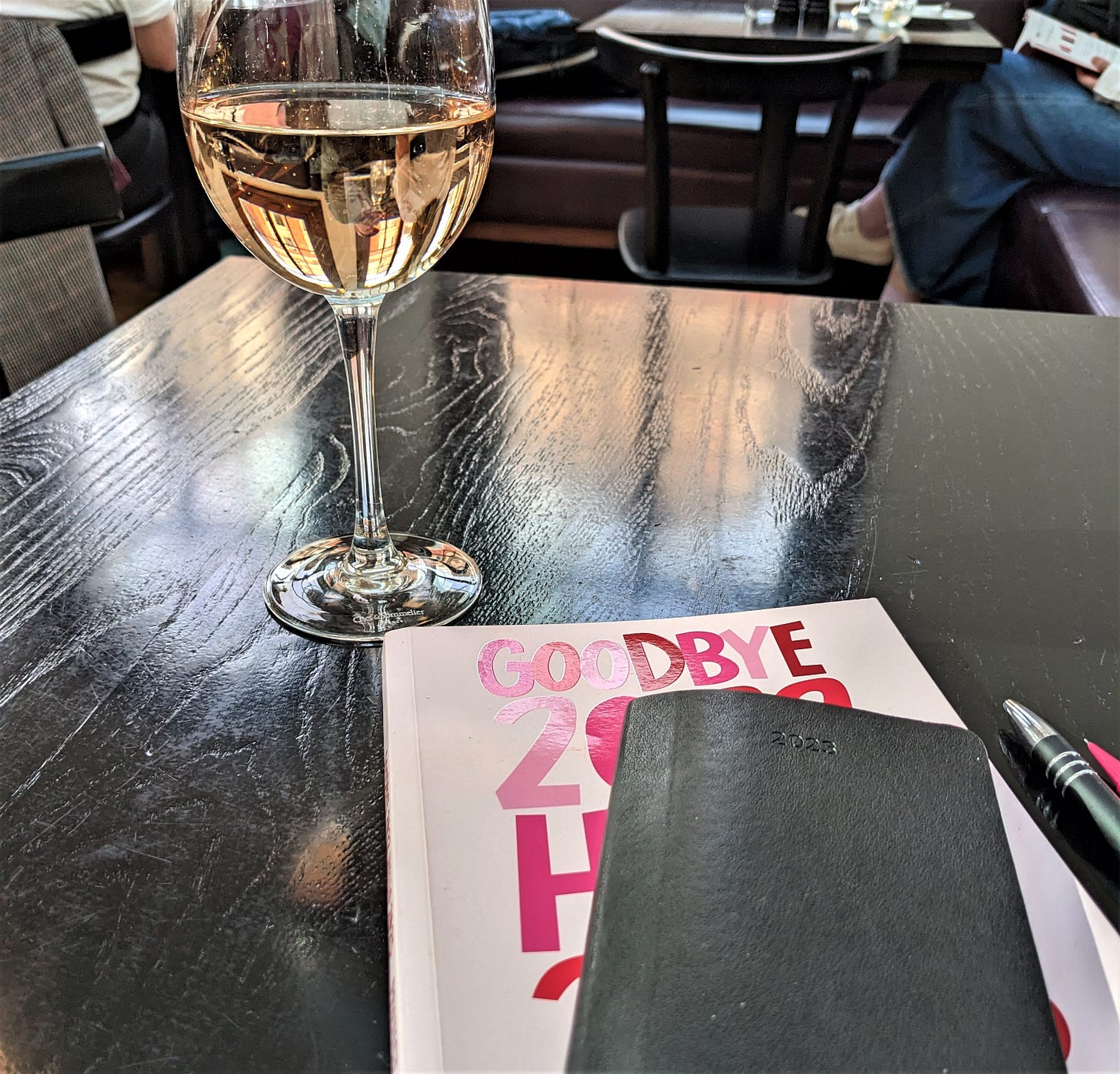
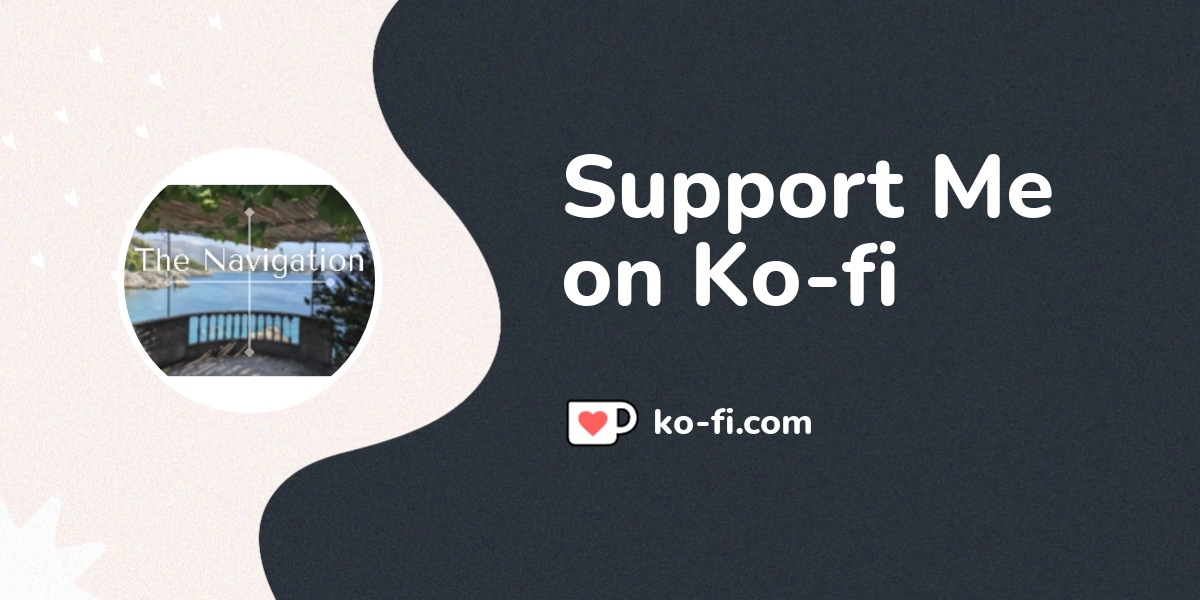
Wait, what !? I had never seen this! Ahhh Lauren. And then Auste is here in the comments. And wait, YOU wrote the Lazy Women piece. I had never made that link before. My mind is being blown right now! 😂🥰
Feels like I wrote it, so relatable! Thanks for sharing!